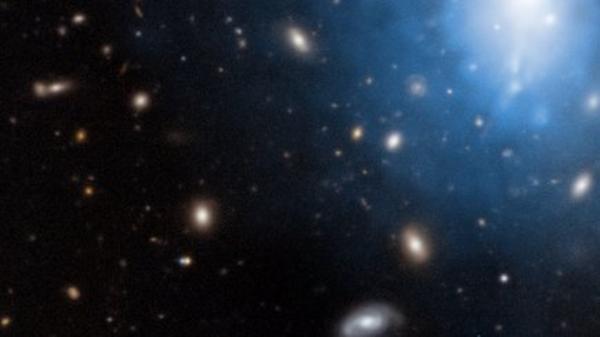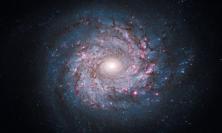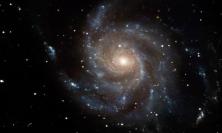Science tells us that the Universe is expanding, that the Sun will eventually burn out, and that our world will inevitably end – billions of years from now – in a cold nothingness. Vatican astronomer, Guy Consolmagno SJ, examines this prospect, and its implications for our belief in eternal life, in the last of his four-part series for Thinking Faith.
Point a telescope in any direction at random, and you'll see lots of stars. The longer you look, the fainter the stars you see; but only to a certain point and no fainter. Our galaxy is only so big; look further, or fainter, and you run out of galaxy, you run out of stars.
In the 1920s we finally realized there are more galaxies out there than just ours. Indeed, the faintest objects in a typical telescope CCD image are not stars some thousands of light years away, but entire galaxies of stars some hundreds of millions of light years away. So far it looks like there are some 200 billion galaxies in the observable universe. Each one has about a hundred million stars. That’s a lot of places to boldly go where no man has gone before.
Galaxies are not spread out evenly through space, but rather you’ll have a grouping of ten or twenty or thirty galaxies in a lump, and then an enormous amount of empty space, and then another lump, another cluster of ten or thirty galaxies.
We know that planets and the sun attract each other via gravity; but the planets revolve around the sun, the centrifugal effect of their motion balancing the force of gravity and stopping them from falling together. Stars within a galaxy, likewise, orbit around the centre of the galaxy and thus are held out from falling into the centre. And galaxies in a cluster all revolve around the centre of the cluster, keeping them from falling together.
So do all the galactic clusters move in some great rotation around the centre of the Universe? Fact is, we see no evidence of any such motion. But if there is no centre to the Universe, what stops the galaxy clusters from all falling together? If the Universe is infinite and eternal, then it should have happened by now.
Albert Einstein worried about this question of what holds the universe up. His general theory of relativity showed that gravity warps space, and the gravity of the galaxies should warp themselves together, unless there was some unknown force in the universe to counter gravity at very large distances.
But Georges Lemaître, a diocesan priest from Belgium with a doctorate from MIT, had another idea. As a mathematician, Lemaître could “read” an equation the way that you or I could read a book. And the equations of General Relativity were telling him that the universe should in fact be expanding from a primordial point — he thought of it as a sort of super-energetic quantum level, which he called a “cosmic seed” — and that this expansion would explain, at least in part, why the galaxy clusters hadn’t fallen together… at least not yet. And, indeed, this expansion should be visible even today. Lemaitre’s friend and rival, Fred Hoyle, tweaked him by calling this the “Big Bang” theory.
Lemaître was a mathematician; he didn’t use a telescope. But he knew someone who did. At the same time as he was coming up with his theory of an expanding universe, Edwin Hubble was observing the position and motion of distant galaxy clusters.
Measuring the distance and the motions of far-off galaxies is tricky, but Hubble had worked out ways to do it. And what he found was that the further away the galaxies were, the faster they appear to be moving away from each other. That’s exactly what you expect if everything was expanding out from a point; the ones that have moved the furthest must be the ones going the fastest.
There are profound implications for this expanding universe.
We can extrapolate backwards to a time when the galaxy clusters were much closer together. Indeed, we can look at far distant galaxies, places whose light is only reaching us now, having travelled for billions and billions of years, and see how the galaxies back then compare with the nearby galaxy clusters today. (My boss, the new director of the Vatican Observatory, Fr. Jose Funes, does just that.) By looking far away, we look back in time. We can even extrapolate to a time before there were galaxies, when there was so little space in space that the mass in their stars was compressed to unbelievably high pressures, to the point where it did not exist as mass — did not exist yet as mass — but rather as extremely hot energy. And we can calculate how long that expansion has been going on. The best number to date is 13.7 billion years.
Indeed we can look back into the very echo of the initial radiation. Not all the energy turned itself into mass; some of the energy that filled the universe then, still fills the universe today. Only the universe has got bigger, so the energy is more spread out, red-shifted, cooler. Rather than billions of degrees, we are talking now about three degrees above absolute zero.
The first trace of that radiation, the three-degree blackbody radiation discovered in the 60s, is what convinced people that the Big Bang really happened. That cosmic background radiation was mapped out in much greater detail by the COBE spacecraft, launched about fifteen years ago to look for the slightest variations in this three degree radiation. It showed us the slight inhomogeneity that was around when the background radiation was being parcelled out, which eventually broke the universe into individual clusters of galaxies.
Now remember, the Big Bang is not about stuff spreading out into an otherwise empty universe. Rather, what is going on is that space itself is spreading out… the space between the galactic clusters, at any rate. At the “beginning” when all matter was concentrated into a point, that point was the entire universe and nothing existed, not even nothingness, except for it. This strange idea follows from Einstein’s General Theory of Relativity, which says that the mass of the Universe warps space; and thus the mass of the Universe, warped into a point, warps space into that point as well.
One of the implications of our expanding universe theory is that we can use the same physics not only to explain what we see happening in the past, but also to predict what will happen in the future. Of course, our predictions are nowhere near as certain; we can look into the past, but we can’t look into the future. Still, it is intriguing to speculate: is the Universe “open” or “closed”?
A “closed” universe has enough mass in it that eventually the pull of its gravity will overcome the initial velocity of the “Big Bang” and cause the galaxies to collapse… the warp of space means that the motion of all the galaxy clusters eventually will bring them together again. Some people have speculated that a closed universe would, in this way, eventually form itself back into a hot singular point, ready to re-explode into a subsequent “Big Bang.” On the other hand, an “open” universe will just keep expanding forever, the clusters of galaxies growing further and further apart, forever.
So, is our universe open or closed? It all depends on the balance of forces between the initial push that caused the Big Bang to bang and the gravity that wants to pull it all back together again. The strength of the gravity depends on how much mass you have in the universe; the “average density” of the universe.
If you look at the density of nearby stuff that you see in the universe, all the stars and galaxies of stars we can see from here, and add it up to see if there’s enough mass there to pull everything back together, you find that you’re short by a factor of twenty-five or so. There just aren’t that many stars around.
But if you look at galaxies themselves closely, and see how the stars orbit around the centres of the galaxies, then compare their speeds with what you’d expect from the gravity of the stars you can see, there’s a mismatch. It really looks like there is matter we can’t see — lots of matter we can’t see. There are more subtle arguments, coming out of the theory of how atomic and subatomic particles are formed, that confirm this result in spades. There is more to the universe than meets the eye. We call this mass “dark matter” – and it appears to be four times more abundant than the ordinary matter of stars and planets.
But even more than that, the energy pushing the universe apart also has a gravitational effect. We call it dark energy. Indeed, recent results appear to suggest that this energy may actually account for 75% of all the mass and energy of the universe. And it appears to be not only driving the expansion of the Big Bang, but even now causing the expansion to accelerate.
Indeed, extrapolating madly from the limited data in hand, it looks like the time may come when expansion of the universe will speed up so much that every other cluster of galaxies will be moving away from our local group of galaxies faster than the speed of light. (That doesn’t violate Relativity because we’re not talking about things moving through space, but space itself expanding ever faster). When that happens, we won’t be able to see them anymore. If we were doing astronomy at that time, we would never be able to see enough of the universe to know that it was expanding, to know that it started in a Big Bang. (Which makes you wonder what important physical facts about the universe are hidden from us even now!)
If and when that happens, we’ll appear to be all alone in the Universe, just us and our local stars. And those stars won’t burn forever.
Stars are powered by nuclear reactions that release energy when hydrogen is fused into helium, and helium into carbon, and carbon into heavier elements. But even here, there’s a limit. It turns out that the bottom of the energy pool comes when you’ve fused all the lighter elements into iron. Beyond that, making heavier elements out of iron actually starts to consume energy. (That’s one reason why elements heavier than iron, like gold and platinum and uranium, are relatively rare; and why you can get energy from breaking up uranium, whereas you also get energy by fusing together hydrogen.)
Judging from what we know about how fusion reactions take place (the stuff of hydrogen bombs – we can actually produce this energy in the lab and see how its works) it’s pretty straightforward to predict the different stages that a star goes through from the time it first forms to when it settles down to a steady shine, to when it goes through its last gasps as the fuel in its core (where the fusion takes place) runs out.
What’s more, we can see all the stages predicted by our theories actually taking place in stars close by to us. It’s pretty well established, then, that in about five billion more years our Sun’s core will have gone through its supply of nuclear fuel. When the core can no longer produce energy, it will cool off and contract; then the mass of gases above the core will come crashing down onto it, bounce, and puff themselves out into a cool, dull-red cloud that (judging from the size of the “red-giant” stars we can see near by) will almost certainly envelop the Earth itself. That will certainly end all life, on Earth at least.
Once the Sun’s dead core cools off, it’ll be nothing but an inert iron-rich ember. Of course, the outer gases of the Sun (and other stars of its generation), spewed into space at this time, will be available to make new stars. So, possibly, life from Earth could fly off in a spaceship and look around for a younger star, once ours is gone.
But those gases, formed into a new star, will eventually fuse and then puff out into another red giant, leaving much of its mass in a cooling core as another iron clinker.
And meanwhile, of course, the Universe continues to expand. As starlight goes out into the ever-increasing void, it must spread its energy thinner and thinner. Eventually, inevitably, all the energy in the Universe will be dissipated through this space, all the mass turned into cold lumps of iron. No stars will shine; no sunshine will exist to fuel life. Eventually, even the most stable of the atomic particles in these inert atoms will decay into radiation that becomes more and more feeble as the space into which it radiates becomes bigger and bigger, in the relentless expansion of the universe. It turns out that, if you wait long enough, even the nuclei in the cold lumps of dead stars will eventually decay into radiation. Even the black holes will eventually dissipate.
Now this may take a hundred billion years, but eventually it will happen — assuming we have our physics right. And if the universe keeps expanding the radiation will get colder and colder. (Heck, the leftover radiation from the fireball that was the Big Bang has already cooled down to just under three degrees above absolute zero… and it’s not getting any warmer.)
Once we’re in the state of an expanding empty universe with ever-expanding radiation, nothing more will happen. Nothing more can happen. There’ll be no reservoirs of “hot” energy, no sinks of “cold” left over anywhere to power engines to overcome entropy. We’ll have arrived at the “heat death” of the Universe. This is the way the world ends: not with a bang, but a whimper.
Indeed, if you look at the length of time when the Universe is fresh enough to have stars still burning, and planets full of life for them to shine on, compared to the time when all the stars are out and the radiation left is gliding into inertness, you’ll see that we on our life-filled Earth are nothing but the Universe in its raucous, fecund infancy. Most of time, in this view — indeed, virtually all of Eternity — will be spent in that ever-quieter whimper.
Or will it? What does traditional Christianity say about the end of the universe? Less than you might think. Or, maybe, more than you might think. Depends on what you think.
The key tool borrowed from Greek and medieval philosophy which seems to be needed to make this existence-without-a-physical-universe to work, is the concept of a “soul.” But what do we really mean by soul?
Perhaps you can think of the soul as analogous to the data in a computer. (Like all analogies, this one will fail miserably when pushed too far; but at least perhaps it can help illustrate some of the issues involved in defining just what it is that survives after death.)
Let’s say you and I own identical computers. But I know mine is different to yours (beyond the fingerprints on the screen and the scratches on the case) because it has a completely different set of files to yours. Perhaps even a completely different operating system. It’s not a matter of a physical difference. The computers could be identical models, and have exactly the same size, shape, weight, and so forth. The only physical difference is that certain magnetic grains representing ones and zeroes are magnetised differently on my hard drive than on yours. But the real difference between the computers is in the ideas present, which are represented by the arrangement of those grains on each hard drive.
This difference cannot be found except for that most subtle difference in grains that represent ones and zeroes. Even the ones and zeroes by themselves have no significance except in terms of the operating system that interprets them; and even the operating system can only translate those ones and zeroes into bits of light on the screen that we humans can identify as letters, words, or pictures, which it takes a human intellect to translate into ideas.
Note that the computer program does not have any existence in space and time without the grains on the hard disk. And in the same way, we humans are creatures made in a physical universe: a universe where the Second Person of the Trinity is also incarnate, Whose resurrected body – while it may be able to do things our bodies cannot, like appear and disappear – can still be touched by a doubting Thomas, and still enjoy a fish dinner. We too are promised eternal life. But what happens to us between the end of our lives, the end of the universe, and the resurrection at the end of time?
Perhaps in some sense the centre of human identity – call it, if you wish, the soul – can maintain a hypothetical existence even in the absence of a particular physical manifestation, in the same way that the idea of a song or a poem can live on even after every copy of it has been destroyed. Perhaps it is in the power of abstract ideas, the nature of words themselves, that we find the best analogy to understand how we can exist even when our bodies turn to dust.
Maybe we’ve been given our clearest hint from Him who was the first example of that eternal, physical existence. Jesus himself, before his death and resurrection, put it simply and directly. “Heaven and Earth will pass away,” he said, “but my words will never pass away.”
Guy Consolmagno SJ is an American Jesuit working at the Vatican Observatory in Castel Gandolfo, Italy, where he conducts research on asteroids and comets, and serves as curator of the Vatican’s collection of meteorites. He is the author of several popular books on astronomy and religion.
This series of articles is adapted from talks given at the Jesuit Living Theology seminar held at Ushaw College from 25 - 29 March 2008. Included in these texts are extended quotations from the author's previously published material, notably from God’s Mechanics: How Scientists and Engineers Make Sense of Religion (Jossey-Bass, 2008); copyright and all rights reserved.
![]() The Vatican Observatory
The Vatican Observatory
![]() God's Mechanics: How Scientists and Engineers
God's Mechanics: How Scientists and Engineers
Make Sense of Religion by Guy Consolmagno SJ






